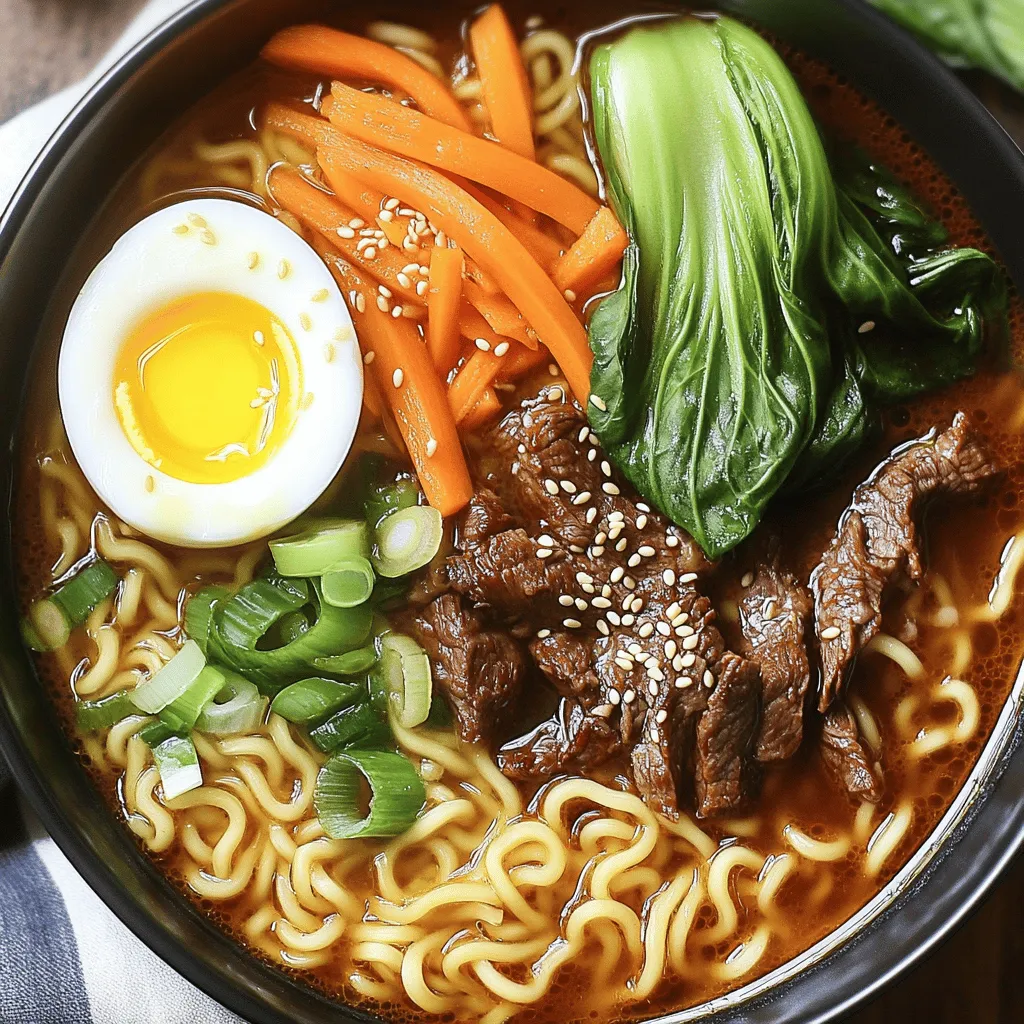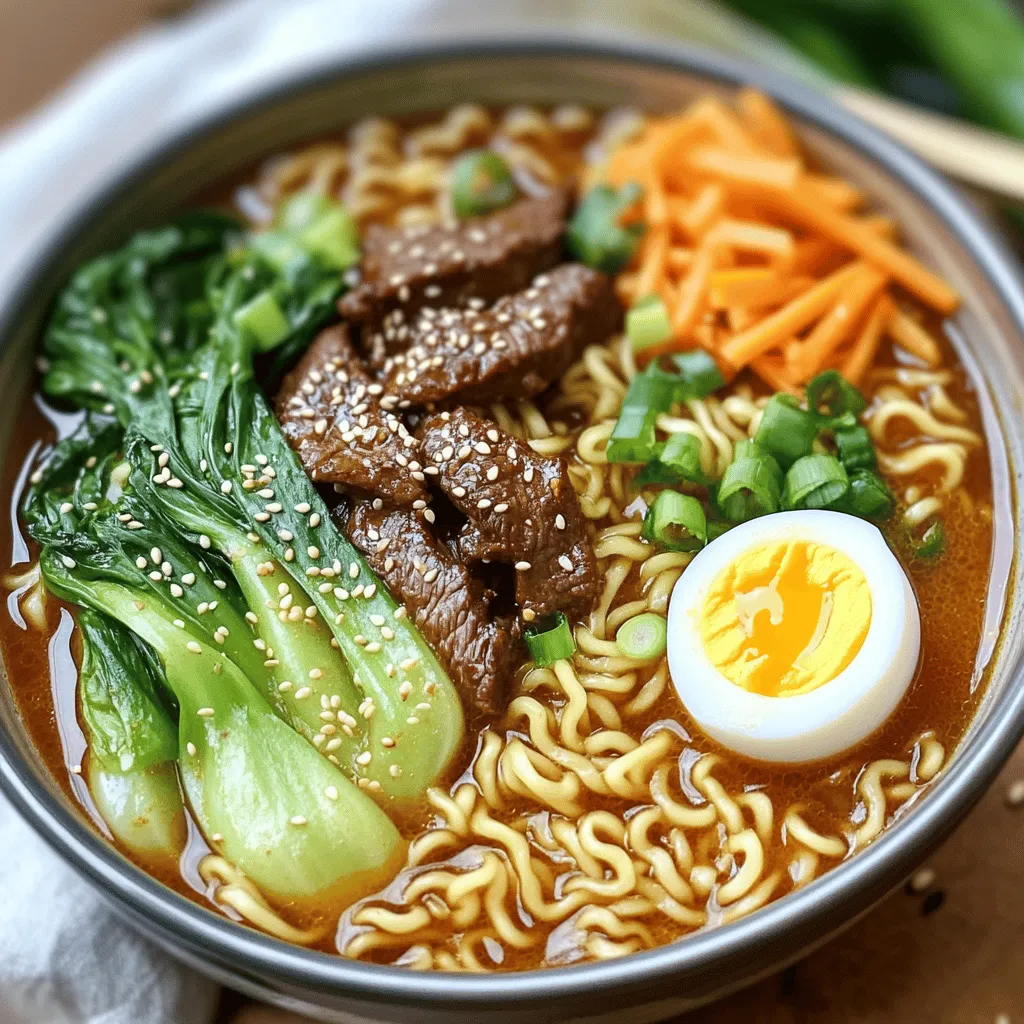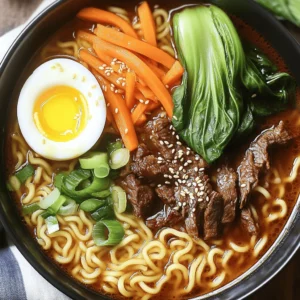Spicy Korean Beef Ramen Flavorful and Satisfying Meal

Are you ready to spice up your dinner routine? My Spicy Korean Beef Ramen is a flavorful and satisfying meal that brings bold taste to your table. With tender beef, slurp-worthy noodles, and a kick from gochujang, this dish hits all the right notes. Join me as I guide you through the simple steps to create this mouthwatering ramen in your own kitchen!
Ingredients
Main Ingredients for Spicy Korean Beef Ramen
– 200g ramen noodles
– 200g beef sirloin, thinly sliced against the grain
The ramen noodles are the heart of this dish. They soak up the rich broth and add a chewy texture. I prefer using fresh ramen noodles when possible. They cook quickly and bring a lively taste to your meal. The beef sirloin adds a savory flavor. Thin slices work best, as they cook fast and remain tender.
Flavor Enhancers
– 2 tablespoons gochujang (Korean chili paste)
– 1 tablespoon soy sauce
– 1 tablespoon sesame oil
Gochujang is the star here. It brings a spicy kick and depth of flavor. Add soy sauce for saltiness and umami. Sesame oil gives a nutty aroma that pulls the dish together. These flavor enhancers are what make this ramen unforgettable.
Vegetables and Toppings
– 1 cup bok choy or fresh spinach, roughly chopped
– 1 medium carrot, julienned
– 2 green onions, chopped (whites and greens kept separate)
Fresh greens add color and crunch. Bok choy or spinach brings vitamins and a slight earthiness. Carrots add natural sweetness, balancing the spice. Green onions add a fresh bite. They also make for a beautiful topping. Each vegetable contributes to the overall taste and texture, making every bite a delight.
Step-by-Step Instructions
Preparing the Beef Marinade
To start, marinate the beef sirloin. In a bowl, mix the thinly sliced beef with gochujang, soy sauce, minced garlic, and grated ginger. Make sure you coat the beef evenly. Cover the bowl and let it sit for at least 15 minutes at room temperature. This step adds great flavor.
Making the Beef Broth
Next, we make the beef broth. In a large pot over medium heat, combine the beef broth, sesame oil, and brown sugar. Add the white parts of the chopped green onions. Bring this to a gentle simmer. Let the flavors meld together for about five minutes. This will create a rich base for your ramen.
Cooking the Beef and Noodles
While the broth simmers, cook the beef. Heat a small drizzle of oil in a skillet over high heat. Once hot, add the marinated beef. Stir-fry it quickly until browned, about three to four minutes. Then transfer the cooked beef to a plate and set it aside. Now, return to the pot with the simmering broth and add the ramen noodles. Cook them according to the package instructions, usually four to five minutes, until they’re tender.
Final Assembly of Ramen
In the last minute of cooking the noodles, add the chopped bok choy or spinach and the julienned carrots to the pot. Stir gently to wilt them while keeping some texture. Now, it’s time to assemble! Divide the cooked ramen and vibrant veggies into large serving bowls. Carefully ladle the hot broth over the noodles and vegetables. Top each bowl with the stir-fried beef. For a creamy touch, add a soft-boiled egg cut in half if you’d like. Finally, sprinkle the chopped green onion tops and toasted sesame seeds over the ramen. Enjoy your meal!
Tips & Tricks
Perfecting the Broth Flavor
To make the broth taste amazing, balance is key. You can add a bit of brown sugar to cut through the saltiness of soy sauce. This mix gives the broth a rounder flavor. It is like a dance of sweet and salty that makes every sip delightful. Taste it while cooking. Adjust it until you find what feels right for you.
Cooking Noodles to Perfection
To avoid overcooking ramen, watch the clock closely. Fresh ramen noodles usually need just 4-5 minutes in boiling broth. Stir them gently as they cook. This helps them cook evenly and not stick together. If you are unsure, taste a noodle. It should be tender, but still have a little bite.
Vegetable Cooking Tips
To keep veggies fresh and crunchy, add them in the last minute of cooking. Bok choy or spinach should wilt just enough to be soft but still bright. Carrots should stay crisp, adding a nice crunch. This way, your ramen looks colorful and tasty!

Variations
Alternative Proteins
You can swap beef for chicken or tofu in this recipe. Chicken adds a lighter touch. It cooks fast and soaks up flavors well. Tofu is great for a plant-based meal. Use firm tofu for the best texture. Just remember to press it to remove excess water. This helps it absorb the marinade better.
Adjusting Spice Levels
Want a milder dish? Reduce the gochujang to one tablespoon. You can also add a bit of sugar for balance. To make it spicier, add more gochujang or even a splash of chili oil. Taste as you go, so you find your perfect heat level.
Adding Extra Vegetables
Feel free to add more veggies to your ramen. Zucchini, bell peppers, or snap peas work great. You can also use seasonal greens like kale or Swiss chard. Just chop them into bite-sized pieces for easy eating. Add them in the last minute of cooking for the best texture.
Storage Info
How to Store Leftovers
To store your leftovers, let them cool first. Place the ramen, broth, and beef in separate airtight containers. This keeps everything fresh. Seal tightly and refrigerate. Enjoy your meal within three days for the best flavor.
Reheating Tips
Reheat ramen slowly to keep its texture. Use a pot on low heat for the broth. For the noodles, heat them in a little boiling water for one to two minutes. This method helps them stay firm and not mushy. Avoid using the microwave, as it can overcook the noodles.
Freezing Ramen for Later
If you want to freeze ramen, separate the components first. Freeze the broth in a freezer-safe bag or container. Place the noodles in a different bag. You can also freeze the beef separately. This way, everything stays fresh and tasty. When ready, thaw overnight in the fridge and reheat as mentioned above.
FAQs
What is Gochujang and how is it used?
Gochujang is a spicy Korean chili paste. It adds heat and depth to dishes. Made from red chili powder, fermented soybeans, and salt, it has a sweet and savory flavor. In this recipe, gochujang is the star. It gives the beef a bold kick. You mix it with soy sauce, garlic, and ginger. This marinade helps tenderize the meat and infuses it with flavor.
Can I make this dish vegetarian?
Yes, you can make a vegetarian version. For the beef, use tofu or mushrooms. Marinate them just like the beef. Replace beef broth with vegetable broth for a lighter taste. You can also add more veggies. Consider using bell peppers, zucchini, or snap peas. These will add color and crunch. This way, you keep the delicious flavor without meat.
What can I serve with Spicy Korean Beef Ramen?
You can serve this ramen with many sides. A simple cucumber salad pairs well. The coolness of the salad balances the heat of the ramen. You could also serve steamed rice. It soaks up the savory broth nicely. For a fun touch, offer kimchi on the side. Kimchi adds a tangy crunch, enhancing the meal. Enjoy the ramen with your favorite drink, like iced tea or lemonade.
In this post, we explored making spicy Korean beef ramen. We looked at key ingredients like beef, noodles, and gochujang. You learned how to prepare the beef and broth, cook the noodles, and assemble your dish. We shared tips on perfecting flavors, cooking noodles, and variations for proteins and spices. Finally, we discussed storing leftovers and reheating for the best taste. Enjoy your cooking journey, and trust that you can customize this dish to your liking!


![- 2 boneless, skinless chicken breasts - 4 cups frozen sweet corn - 1 medium onion, finely diced - 2 cloves garlic, minced - 2 medium-sized potatoes, peeled and diced - 3 cups chicken broth (low-sodium if preferred) - 1 teaspoon dried thyme - 1 teaspoon smoked paprika - 1 teaspoon salt (adjust to taste) - 1/2 teaspoon black pepper - 1 cup heavy cream - 1 tablespoon fresh parsley, finely chopped (for garnish) - Chicken Breasts: These give the chowder its protein and heartiness. Boneless and skinless cuts work best for easy shredding. - Frozen Sweet Corn: This adds natural sweetness and a nice texture. Frozen corn saves time and adds flavor. - Onion and Garlic: These aromatics enhance the overall taste. They create a flavorful base for your chowder. - Potatoes: Diced potatoes add creaminess and body. They also soak up all the lovely flavors. - Chicken Broth: This liquid forms the chowder's base. Low-sodium broth lets you control the salt. - Heavy Cream: This ingredient adds richness and smoothness. It makes the chowder feel indulgent. - Dried Thyme and Smoked Paprika: These spices give depth and warmth. They create a lovely, savory taste. - Chicken: You can use turkey or tofu for a different protein. - Corn: Fresh corn works instead of frozen if you have it. - Cream: Swap heavy cream for coconut milk for a dairy-free option. - Potatoes: Cauliflower can replace potatoes for a lower-carb choice. - Broth: Use vegetable broth for a vegetarian version. - Herbs and Spices: Feel free to mix in your favorite seasonings or herbs. This recipe is flexible, allowing you to create a chowder that fits your taste and needs. Check out the Full Recipe for cooking instructions and enjoy making this hearty meal! To start, gather all your ingredients. You’ll need chicken, corn, onion, garlic, potatoes, and broth. Place the chicken breasts at the bottom of the crockpot. Next, add the corn, onion, garlic, and potatoes on top of the chicken. This order helps the chicken cook well. Pour the broth over everything, covering the ingredients completely. Sprinkle in the thyme, paprika, salt, and pepper. Use a spoon to mix them gently. Set your crockpot to cook on low for 6-8 hours or high for 4 hours. The low setting gives the best taste and texture. The chicken will be very tender when done. You can check for doneness by cutting into the chicken; it should be white and juicy. About 30 minutes before serving, take the chicken out of the pot. Use two forks to shred it into small pieces. This will help it absorb more flavors. After shredding, return the chicken to the chowder. Mix it well. This step adds heartiness to your meal. Enjoy the rich, creamy goodness of this chowder! For the complete recipe, refer to the [Full Recipe]. To boost the flavor of your chowder, try using fresh herbs. Fresh thyme or basil can add a bright touch. You can also add a squeeze of lemon juice before serving. This gives a fresh and zesty kick. For a smoky flavor, increase the smoked paprika. If you like heat, add a pinch of cayenne pepper. This will make your chowder more exciting without overpowering it. One common mistake is not seasoning enough. Always taste your chowder before serving. Adjust the salt and pepper to your liking. Another mistake is overcooking the chicken. If you leave it in too long, it can become dry. Remember to shred the chicken about 30 minutes before serving. This keeps it juicy and flavorful. Lastly, don’t skip the cream. It adds richness and a nice texture to your chowder. Garnishing can make your chowder look appealing. I love using fresh parsley for color and freshness. Chopped green onions also add a nice crunch. A dollop of sour cream can enhance creaminess and flavor. For a fun twist, sprinkle some crispy bacon bits on top. This adds a salty crunch that contrasts well with the smooth chowder. Serve with warm bread for a complete meal. {{image_4}} You can boost the health of your chowder by adding more veggies. Carrots, bell peppers, or zucchini work great. Chop them into small pieces so they cook well. You can add them when you put in the corn and potatoes. This way, they cook together and soak up all the yummy flavors. If you need a gluten-free dish, this chowder is already a great choice. Just make sure the chicken broth you use is gluten-free. Most store-bought broths are, but it's always good to check the label. This chowder is warm and filling without any gluten. Want to add some heat? You can make your chowder spicy! Add diced jalapeños or a pinch of cayenne pepper. Start with a little and taste it. You can always add more if you like it hot. This twist will give your chowder a fun kick and make it even more exciting. For more ideas and a complete guide, check out the Full Recipe. After you finish your meal, let the chowder cool. Store it in an airtight container. It will stay fresh in the fridge for about 3 to 4 days. If you want to keep it longer, consider freezing. To freeze your chowder, first cool it completely. Then, pour it into freezer-safe bags or containers. Make sure to leave some space for expansion. You can freeze it for up to 3 months. When ready to eat, just thaw it overnight in the fridge. When it’s time to enjoy your chowder again, reheat it gently. You can use the stove or microwave. If using the stove, heat it on low and stir often. If it seems too thick, add a splash of chicken broth or water. This will help bring back the creamy texture. Enjoy your warm and hearty meal! You can store leftover chowder in the fridge for up to four days. Keep it in an airtight container. If you want to keep it longer, freeze it. It can last up to three months in the freezer. Just make sure to thaw it overnight in the fridge before reheating. Yes, you can use fresh corn! Just cut the kernels off the cob. You will need about four ears of corn to replace the frozen version. Fresh corn adds a lovely crunch and sweetness. Just add it to the crockpot at the same time as the other ingredients. Crockpot Chicken Corn Chowder goes well with many sides. Here are some great options: - Crispy bread - Buttered rolls - Green salad - Garlic bread - Cornbread These sides add texture and complement the chowder's flavors. To make this chowder vegetarian, replace chicken with firm tofu or chickpeas. Use vegetable broth instead of chicken broth. You can also add more veggies, like bell peppers or zucchini. This way, you keep the chowder hearty and tasty without meat. This chowder is rich and filling. A serving has about: - 350 calories - 15 grams of fat - 30 grams of carbs - 20 grams of protein These values can change based on the ingredients you use. Check the labels for exact numbers if you substitute items. For the full recipe, refer to the earlier section. This blog post covered all you need to make tasty Crockpot Chicken Corn Chowder. We explored key ingredients, helpful cooking steps, and tips to enhance flavor. I shared variations to fit your diet and storage info to keep leftovers fresh. Remember, making chowder can be fun and easy. Experiment with flavors and enjoy your meal. Happy cooking!](https://fastmealmate.com/wp-content/uploads/2025/07/7342804b-764e-40da-bca1-0102f439c2b1-768x768.webp)



![To make Easy Roasted Tomato Soup, gather these key ingredients: - 2 pounds of ripe, juicy tomatoes, halved - 1 medium onion, cut into quarters - 4 cloves of garlic, left unpeeled - 2 tablespoons of extra virgin olive oil - Sea salt and freshly cracked black pepper, to taste - 1 teaspoon of dried basil - 1 teaspoon of sugar (optional, to counterbalance acidity) - 4 cups of rich vegetable broth - 1/2 cup of heavy cream (optional, for a luscious finish) - Fresh basil leaves, for a lovely garnish These ingredients create a base that bursts with flavor. The tomatoes give the soup its rich taste. The onion adds sweetness, while garlic brings depth. You can add optional ingredients to boost the flavor: - A splash of balsamic vinegar for acidity - A pinch of red pepper flakes for heat - A teaspoon of smoked paprika for a smoky taste These extras can transform the soup into something special. Feel free to experiment and find your favorite combination. To prepare this soup, you’ll need a few handy tools: - A large baking sheet for roasting - A pot for cooking the soup - An immersion blender or a standard countertop blender - A cutting board and sharp knife for prep Having the right tools makes cooking easier. With these, you’ll create a smooth, tasty soup that warms the soul. For the complete recipe, check out the [Full Recipe]. To start, gather all your ingredients. You need: - 2 pounds of ripe, juicy tomatoes, halved - 1 medium onion, cut into quarters - 4 cloves of garlic, left unpeeled - 2 tablespoons of extra virgin olive oil - Sea salt and freshly cracked black pepper, to taste - 1 teaspoon of dried basil - 1 teaspoon of sugar (optional) - 4 cups of rich vegetable broth - 1/2 cup of heavy cream (optional) - Fresh basil leaves for garnish First, wash the tomatoes well. Cut them in half and place them on a baking sheet. Next, quarter the onion and add it to the sheet. Toss in the unpeeled garlic cloves. Now, drizzle the olive oil over the veggies. Sprinkle sea salt, black pepper, and dried basil on top. If you want to balance the soup's acidity, add sugar now. Preheat your oven to 400°F (200°C). Once the oven is ready, slide in your baking sheet. Roast the vegetables for 25-30 minutes. The tomatoes should soften and caramelize. After roasting, take the sheet out and let the veggies cool. Once cool enough to handle, peel off the garlic skins. In a large pot, combine the roasted tomatoes, onion, and garlic. Add the vegetable broth and place the pot over medium heat. Bring the mixture to a gentle simmer. Use an immersion blender to puree the soup until smooth. If you don’t have one, carefully transfer the soup to a blender. Make sure to leave space for steam to escape. If you want a rich finish, stir in the heavy cream now. Taste the soup and adjust the seasoning. Heat until hot throughout. Finally, serve the soup in bowls. Garnish with fresh basil leaves for color and flavor. Enjoy your delicious, comforting bowl of roasted tomato soup! To get a smooth soup, use an immersion blender. It makes blending easy. If you prefer, you can blend in batches with a regular blender. Just leave space for steam. For a thicker texture, add less broth. If you like it thinner, add more broth. You can also stir in heavy cream for extra richness. It adds a nice velvety feel. One mistake is not roasting the tomatoes long enough. They need time to caramelize and develop flavor. Don’t skip the sugar if your tomatoes are very acidic. It balances the taste. Also, remember to peel the garlic after roasting. Skins can affect the smoothness of your soup. Finally, taste your soup before serving. Adjust salt and pepper to match your flavor. Serve your soup hot, garnished with fresh basil leaves. They add color and flavor. Pair it with a grilled cheese sandwich for a classic combo. You can also serve it with crusty bread for dipping. For a twist, add a drizzle of balsamic glaze on top. This adds a sweet tang that enhances the soup. For the full recipe, check the details above. {{image_4}} You can easily make this soup vegan. Just skip the heavy cream. Use more vegetable broth instead. This keeps the soup rich and tasty. The roasted tomatoes give it a great flavor. You won’t miss the cream at all. Add a splash of coconut milk for creaminess if you like. It adds a nice twist! Want to spice things up? Add a pinch of red pepper flakes for heat. A dash of smoked paprika gives a warm flavor. Fresh herbs like thyme or oregano enhance the soup, too. You can also stir in a tablespoon of balsamic vinegar. It adds depth and a little sweetness. Don't forget to taste as you go! This soup is naturally gluten-free. You don’t need any flour or wheat. Just use certified gluten-free vegetable broth. This way, everyone can enjoy it. If you want to thicken the soup, use blended potatoes or a cornstarch slurry. It keeps the soup smooth without gluten. Enjoy this comforting bowl without worries! To store leftover soup, let it cool first. Pour it into an airtight container. Make sure to seal it well. Place it in the fridge. It will stay fresh for about three days. If you want to keep it longer, freezing is better. Freezing is a great way to prepare meals ahead. Use freezer-safe containers or bags. Fill them with soup, leaving some space at the top. This allows for expansion. Label the containers with the date. It can last up to three months in the freezer. When you’re ready to use it, just thaw it in the fridge overnight. To reheat your soup, use a pot on the stove. Heat it gently over medium-low. Stir often to avoid burning. If the soup is too thick, add a splash of broth or water. You can also use a microwave. Heat it in short bursts, stirring in between. Always taste before serving to check the flavor. Adjust seasoning if needed for that perfect bowl of comfort. The best tomatoes for this soup are ripe, juicy varieties. I love using Roma or vine-ripened tomatoes. They have great flavor and are less watery. You can also mix in some heirloom tomatoes for extra depth. Their sweetness adds a lovely touch to the soup. Yes, you can make this soup ahead of time. It keeps well in the fridge for up to four days. Just make sure to cool it completely before storage. You can also freeze it for up to three months. For the best taste, reheat the soup gently on the stove. To make roasted tomato soup without cream, simply skip the heavy cream. Instead, you can add a splash of vegetable broth for richness. For added creaminess, blend in some cooked white beans or cashews. They blend smoothly and give a nice texture without dairy. You’ll still enjoy a flavorful bowl of comfort. For the full recipe, check out the detailed instructions above. In this post, we explored how to make easy roasted tomato soup. We discussed key ingredients, optional flavors, and tools you need. Following the step-by-step instructions ensures success every time. I shared tips for the perfect consistency and common mistakes to avoid. You can even try vegan and gluten-free options. Lastly, I covered storage and reheating for later enjoyment. Enjoy making this warm soup and share it with others.](https://fastmealmate.com/wp-content/uploads/2025/07/8c50acbe-b26b-4fce-9348-24a1062b636d-768x768.webp)
